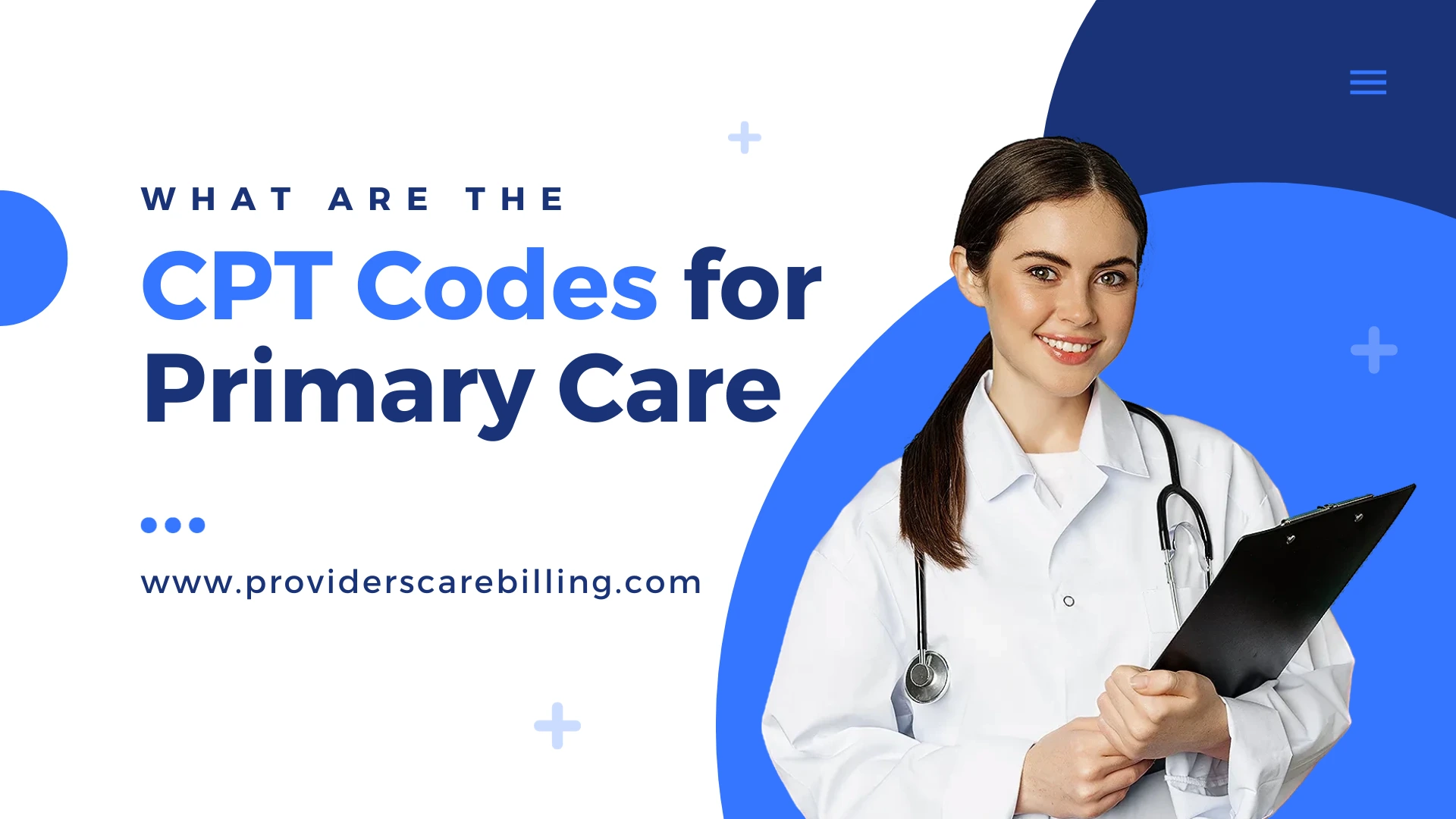Have you ever wondered what hidden language your doctor uses to bill for primary care visits?
Well, you are not alone! Understanding the Common Procedural Terminology (CPT) codes for primary care is like having a cheat sheet for managing the healthcare billing system. In this blog article, we’ll review the most common CPT codes for primary care appointments – think of it your personal Primary Care CPT Code Cheat Sheet. Whether you’re a patient looking for information about your medical bills or a healthcare professional needing a quick reference, we have you covered. Let’s understand those codes and provide you with knowledge of what happens behind the scenes during your primary care visits.
Looking for more information about mental health billing? Check out CPT Codes For Mental Health Psychotherapy Services to see how these codes help manage mental health services.
Understanding of the CPT Coding System
Overview of Current Procedural Terminology (CPT)
CPT billing codes for primary care are like labels for different medical procedures. It’s a system that helps doctors and insurance companies communicate about the services provided during a visit. These codes make it easier to understand what treatments or tests were done. They are a standardised language for medical procedures, ensuring accurate communication between healthcare providers and insurers.
For family care practices, leveraging expert Family Practice Billing Services can significantly enhance billing accuracy and efficiency. Whether your practice is located in, Maryland, or Oregon, specialized billing services tailored to your region can streamline operations and improve revenue cycle management.
Purpose and Use of CPT Codes in Primary Care
CPT codes are extremely important in medical billing and coding. These codes are used to generate billing for doctors’ essential care services. When you read these numbers on your account, they refer to your precise medical treatments or services. CPT codes are used in medical billing and coding services to ensure that healthcare practitioners are properly compensated. It functions as a global language, allowing everyone in the healthcare system to comprehend what occurred during your visit and ensuring appropriate pay for services given.
Here’s the List of CPT Billing Codes for Primary Care
Office Visit Codes
Office visit codes, such as 99202-99205 and 99211-99215, are CPT codes for primary care. These codes are like tags used to bill for the evaluation and management services. They help describe how complicated the visit was, with lower codes for simpler visits and higher codes for more complex ones. Codes like 99211 and 99212 are for minor services, while 99213-99215 and 99202-99205 are for visits needing more thorough examination and decision-making. Doctors should document the visit’s complexity well to ensure correct reimbursement and reduce the chances of audits or denials in medical billing and coding services.
Preventive Visits Codes
Preventive care visits are a big part of doctor visits for check-ups. When doctors want to get paid for these visits, they use CPT billing codes for primary care. The codes in the range 99391 – 99397 are like labels for different preventive services, such as yearly check-ups. The code used depends on the patient’s age and the complexity of the visit. These codes cover physical exams, health screenings, shots, and advice on healthy living. The medical billing and coding company must document everything accurately to ensure the doctor gets paid the right amount for these crucial preventive care services.
Special Primary Care CPT Codes
These labels are commonly used in primary care to describe various diagnostic, screening, and treatment procedures. These codes, like 93306 for echocardiography or 93880 for vascular ultrasound, help doctors specify their services. In medical billing and coding, a company uses codes, such as 76705 for abdominal ultrasound or 93005 for an electrocardiogram, to create accurate bills for the care you receive. Some common CPT codes for primary care include 94640 for nebulizer treatment and 81025 for urinalysis.
Lab Testing Codes
Lab testing codes are like labels for medical tests that doctors commonly order. For example, code 83036 checks haemoglobin A1c, which helps monitor blood sugar levels in people with diabetes. Code 85025 is for a complete blood count (CBC), a standard test for overall health. Code 80053 covers a comprehensive metabolic panel and details kidney and liver function. There are also codes for thyroid and lipid panel tests and infectious disease screenings. These codes are crucial for accurate billing and reimbursement in medical billing and coding for primary care. They help the medical billing and coding company ensure proper payment and effective patient care.
Codes Preventive Medicine Services
Doctors use specific codes, like 99381-99387, for preventive care services from infancy to adulthood. Primary care providers, like family doctors, use these codes to bill for preventive care, not diagnose or treat issues. These codes show a detailed checkup and management for different age groups. Services may include a thorough medical history, physical exams, counselling, risk-reduction advice, and screenings for medical conditions. It’s crucial to document everything properly to ensure doctors get paid correctly. This process is part of medical billing and coding, often handled by a medical billing and coding company, ensuring accurate reimbursement for the provided preventive care services.
Vaccination Codes
These are the codes for vaccines in medical billing. For the human papillomavirus (HPV) vaccine, doctors use CPT code 90649. If you got the meningococcal vaccine, it’s coded as 90736. The influenza vaccine has its code, which is 90636. The hepatitis B vaccine is represented by CPT code 90733. The pneumococcal vaccine uses CPT codes 90632 and 90732. The Rotavirus vaccine is coded as 90691, and the zoster vaccine has code 90746. The measles, mumps, and rubella (MMR) vaccines are under CPT code 90707, while the tetanus, diphtheria, and pertussis (Tdap) vaccines are coded as 90713. Various vaccines, like MMR and Tdap, fall under CPT code 90715. Lastly, the high-dose formulation of the influenza virus vaccine has CPT code 90656.
These codes enable doctors and medical billing and coding companies to bill correctly for vaccines administered during primary care appointments. They guarantee that the correct information is communicated for proper invoicing and payment.
Understanding these codes is essential for accurate billing and reimbursement. For healthcare practices, ensuring these codes are billed correctly often requires outsourcing to professional medical billing services. But how much do such services cost monthly? To explore pricing models and understand medical billing charges, check out our guide on How Much Do Medical Billing Services Charge per Month?
Related Services:
Understanding CPT codes is just one aspect of managing healthcare billing. Providers must also navigate intricate billing procedures, which can be both time-consuming and prone to errors. By outsourcing medical billing to trusted professionals, healthcare providers can reduce administrative burdens, ensure compliance, and minimize billing errors.
Discover specialized medical billing solutions tailored to your practice’s needs in the following regions:
Leverage the expertise of Ohio medical billing services and Georgia medical billing services to streamline your revenue cycle and focus on delivering quality patient care.
Final Thoughts
We conclude that, knowing the most common CPT codes for primary care is crucial for getting medical bills right. Primary care doctors need to understand these codes and what details are needed for each. This helps them bill accurately and avoid problems like audits or denials. There are different codes for various things, like office visits, lab tests, preventive services, special primary care procedures, and vaccinations. It’s super important to use the right code for each service. By following the guidelines and tips for billing with these codes, primary care doctors can make sure they get paid correctly for their services.
Related: CPT Code 99203 and 99204.




